1996 CADILLAC FLEETWOOD transmission
[x] Cancel search: transmissionPage 8 of 306
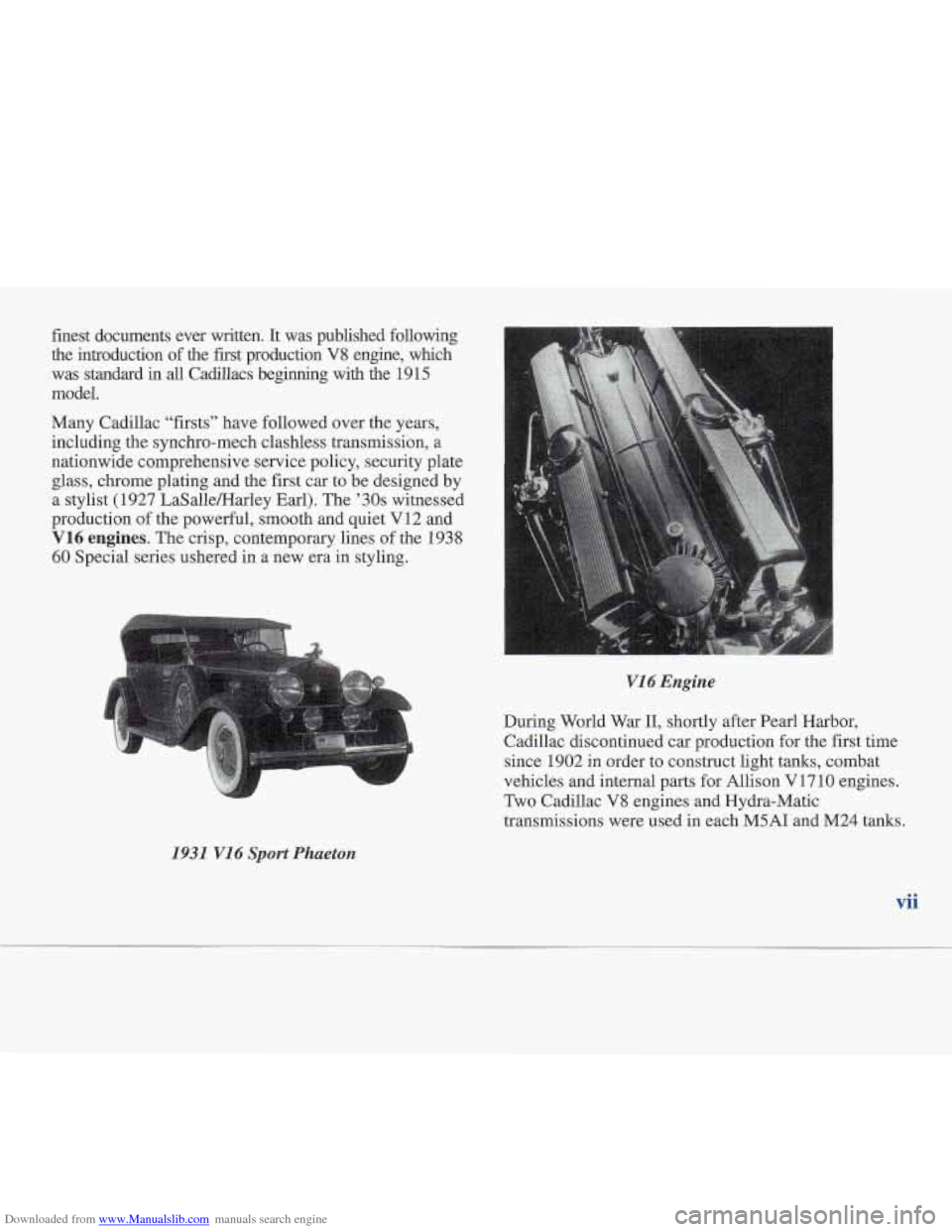
Downloaded from www.Manualslib.com manuals search engine finest documents ever written. It was published following
the introduction of the first production V8 engine, which
was standard in
all Cadillacs beginning with the 19 15
model.
Many Cadillac “firsts” have followed over the years,
including
the synchro-mech clashless transmission, a
nationwide comprehensive service policy, security plate
glass, chrome plating and the first car to be designed by
a stylist (1927 LaSalle/Harley Earl). The ’30s witne.ssed
production of the powerful, smooth and quiet
V12 and
V16 engines. The crisp, contemporary lines of the 1938
60 Special series ushered in a new era in styling.
Vl6 Engine
During World War 11, shortly after Pearl Harbor,
Cadillac discontinued car production for the first time
since 1902 in order
to construct light tanks, combat
vehicles and internal parts for Allison V1710 engines.
Two Cadillac V8 engines and Hydra-Matic
transmissions were used in each MSAI and M24 tanks.
1931 V16 Sport Phaeton
vii
Page 69 of 306
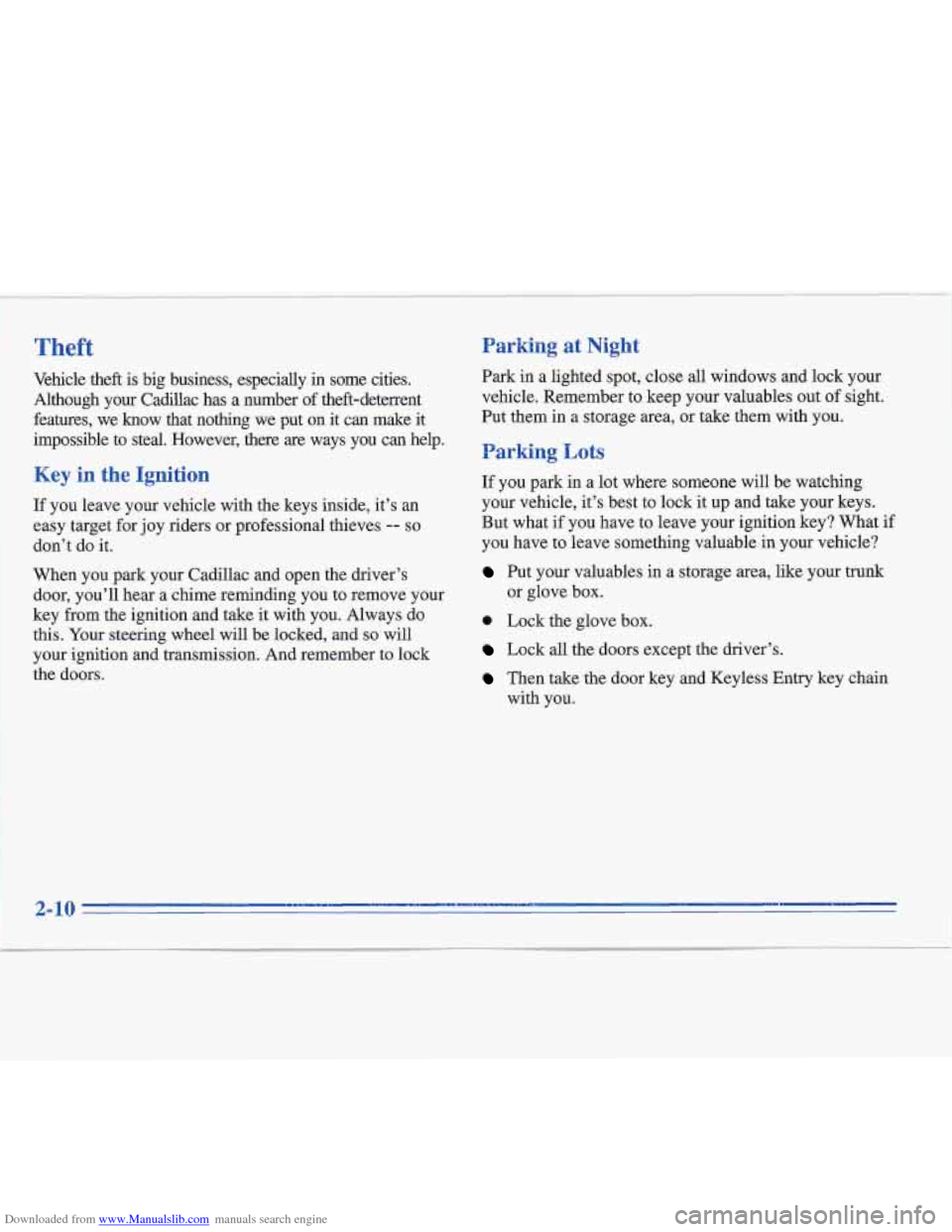
Downloaded from www.Manualslib.com manuals search engine Theft Parking at Night
Vehicle theft is big business, especially in some cities.
Although your Cadillac has a number of theft-deterrent
features, we know that nothing we put
on it can make it
impossible to steal. However, there are ways you can help.
Key in the Ignition
If you leave your vehicle with the keys inside, it’s an
easy target for joy riders or professional thieves
-- so
don’t do it.
When you park your Cadillac and open the driver’s
door, you’ll hear a chime reminding you to remove your
key from the ignition and take it with you. Always do
this. Your
steering wheel will be locked, and so will
your ignition and transmission. And remember to lock
the doors. Park in
a lighted spot, close all windows and lock your
vehicle. Remember to keep your valuables out of sight.
Put them in a storage area, or take them with you.
Parking Lots
If you park in a lot where someone will be watching
your vehicle, it’s best to lock
it up and take your keys.
But what if you have to leave your ignition key? What if
you have to leave something valuable in your vehicle?
Put your valuables in a storage area, like your trunk
or glove box.
0 Lock the glove box.
Lock all the doors except the driver’s.
Then take the door key and Keyless Entry key chain
with you.
Page 74 of 306

Downloaded from www.Manualslib.com manuals search engine LOCK (B): Before you put the key in, your ignition
will be in the
LOCK position. This is the only position
in which you can remove the key. This position locks
your ignition, steering wheel and transmission. It’s a
theft-deterrent feature.
OFF (C): This position unlocks the steering wheel,
ignition and transmission but doesn’t send electrical
power to any accessories. Turn the key
to the OFF
position if you must have your vehicle in motion while
the engine is
off.
RUN (D): This is the position for driving.
START (E): This key position starts your engine.
Note that even if
the engine is not running, the positions
ACCESSORY and RUN allow you to operate your
electrical accessories, such as the radio and ventilation fan.
.~ ~
NOTICE:
If your key seems stuck in LOCK and you can’t
turn it, be sure it
is all the way in. If it is, then
turn the steering wheel left and right while you
turn the key hard. But turn the key only with
your hand. Using a tool to force
it could break
the key or the ignition switch.
If none of this
works, then your vehicle needs service.
Page 75 of 306
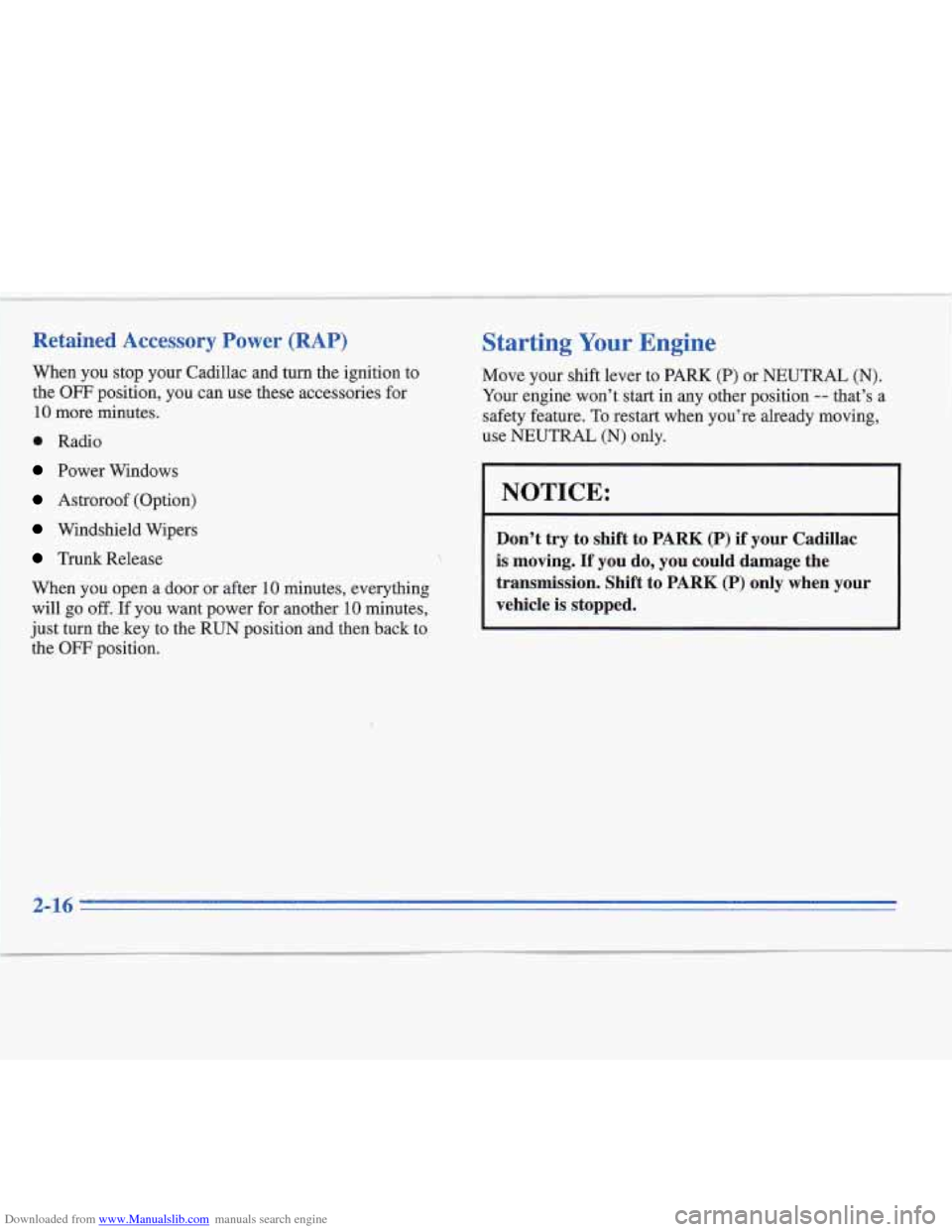
Downloaded from www.Manualslib.com manuals search engine ~~~ ~ ~. ~
Retained Accessory Power (RAP)
When you
stop your Cadillac and turn the ignition to
the
OFF position, you can use these accessories
10 more minutes.
0 Radio
Power Windows
Astroroof (Option)
Windshield Wipers
Trunk Release for
When you open a door or after
10 minutes, everything
will go
off. If you want power for another 10 minutes,
just turn the key to the RUN position and then back to
the
OFF position.
Starting Your Engine
Move your shift lever to PARK (P) or NEUTRAL (N).
Your engine won’t start in any other position -- that’s a
safety feature.
To restart when you’re already moving,
use NEUTRAL
(N) only.
I
I NOTICE:
Don’t try to shift to PARK (P) if your Cadillac
is moving.
If you do, you could damage the
transmission. Shift to
PARK (P) only when your
vehicle is stopped.
2-16
.. .
Page 80 of 306
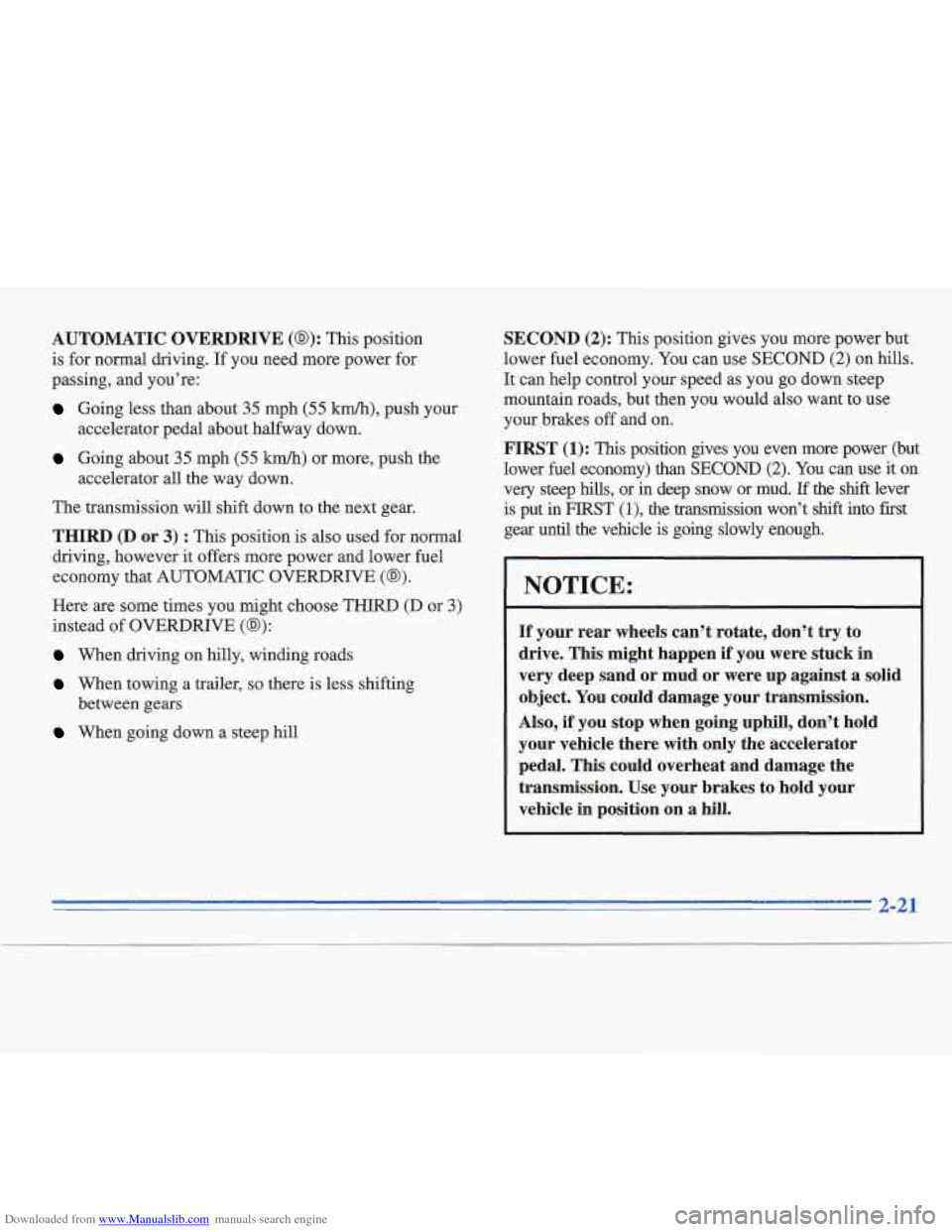
Downloaded from www.Manualslib.com manuals search engine AUTOMATIC OVERDRIVE (@): This position
is for normal driving.
If you need more power for
passing, and you’re:
Going less than about 35 mph (55 km/h), push your
Going about 35 mph (55 km/h) or more, push the
The transmission will shift down to the next gear.
accelerator pedal
about halfway down.
accelerator all the way down.
THIRD (D or 3) : This position is also used for normal
driving, however it offers more power and lower fuel
economy that AUTOMATIC OVERDRIVE
(@).
Here are some times you might choose THIRD (D or 3)
instead of OVERDRIVE (@):
When driving on hilly, winding roads
When towing a trailer, so there is less shifting
When going down a steep hill
between gears
SECOND (2): This position gives you more power but
lower fuel economy. You can use SECOND
(2) on hills.
It can help control your speed as you
go down steep
mountain roads, but then you would
also want to use
your brakes
off and on.
FIRST (1): This position gives you even more power (but
lower fuel economy)
than SECOND (2). You can use it on
very steep hills, or in deep snow or mud. If the shift lever
is put in
FIRST (l), the transmission won’t shift into first
gear until the vehicle is going slowly enough.
NOTICE:
If your rear wheels can’t rotate, don’t try to
drive. This might happen
if you were stuck in
very deep sand
or mud or were up against a solid
object. You could damage your transmission.
Also,
if you stop when going uphill, don’t hold
your vehicle there with only the accelerator
pedal. This could overheat and damage the
transmission. Use your brakes to hold your
vehicle in position on a hill.
Page 85 of 306

Downloaded from www.Manualslib.com manuals search engine Toraue Lock
11 you are parking on a hill and you don’t shift your
transmission into PARR (P) properly, the weight of the
vehicle may put too much force on the parking pawl in
the transmission.
You may find it difficult to pull the
shift lever out of PARK (P). This is called “torque lock.”
To prevent torque lock, set the parking brake and then
shift into PARK (P) properly before you leave the
driver’s seat. To find
out how, see “Shifting Into
PARK
(P)” in the Index.
If torque lock does occur, you may need to have another
vehicle push yours a little uphill to take some
of the
pressure from the transmission,
so you can pull the shift
lever out of PARK
(P).
Shifting out of PARK (P)
Your Cadillac has a brake-transmission shift interlock. You
have to fully apply your regular brakes before you can
shift from PARK (P) when the ignition is in the RUN
position. See “Automatic Transmission” in the Index.
If you cannot shift out of PARK (P), ease pressure on
the shift lever
-- push the shift lever all the way into
PARK
(P) as you maintain brake application. Then
move the shift lever into the gear you want.
If you ever
hold the brake pedal down but still can’t shift out of
PARK (P), try this:
1. Turn the key to OFF. Open and close the driver’s door
to
twn off the Retained Accessory Power feature.
2. Apply and hold the brake until the end of Step 4.
3. Shift to NEUTRAL (N).
4. Start the engine and then shift to the drive gear
you want.
5. Have the vehicle fixed as soon as you can.
2-26
Page 109 of 306
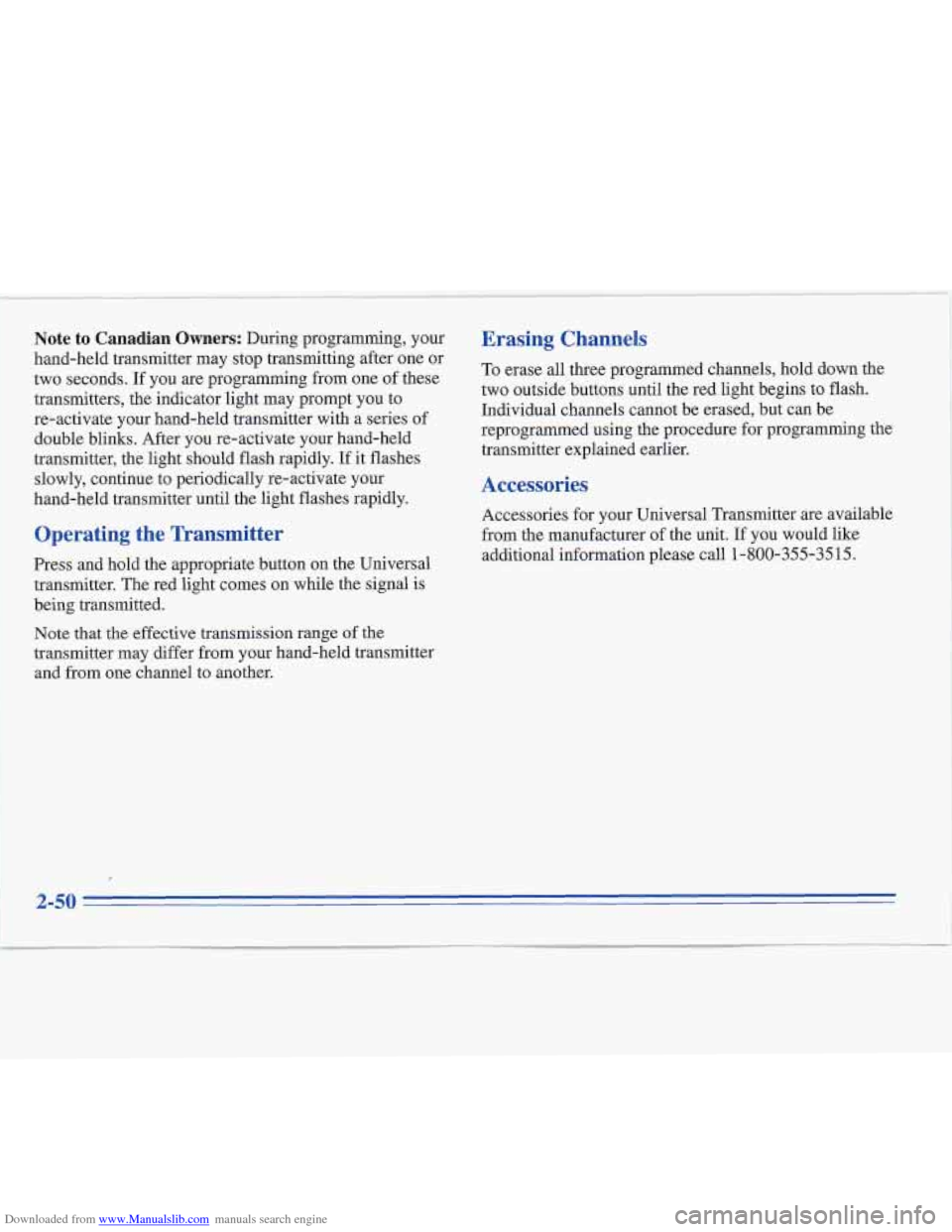
Downloaded from www.Manualslib.com manuals search engine Note to Canadian Owners: During programming, your
hand-held transmitter may stop transmitting after one or
two seconds.
If you are programming from one of these
transmitters, the indicator light may prompt you to
re-activate your hand-held transmitter with a series of double blinks. After you re-activate your hand-held
transmitter, the light should flash rapidly. If it flashes
slowly, continue to periodically re-activate your
hand-held transmitter until the light flashes rapidly.
Operating the Transmitter
Press and hold the appropriate button on the Universal
transmitter. The red light comes on while the signal
is
being transmitted.
Note that the effective transmission range of the
transmitter may differ from your hand-held transmitter
and
from one channel to another.
Erasing Channels
To erase all three programmed channels, hold down the
two outside buttons until the red light begins to flash.
Individual channels cannot be erased, but can be
reprogrammed using the procedure for programming the
transmitter explained earlier.
Accessories
Accessories for your Universal Transmitter are available
from the manufacturer
of the unit. If you would like
additional information please call 1-800-355-3515.
2-50
Page 110 of 306
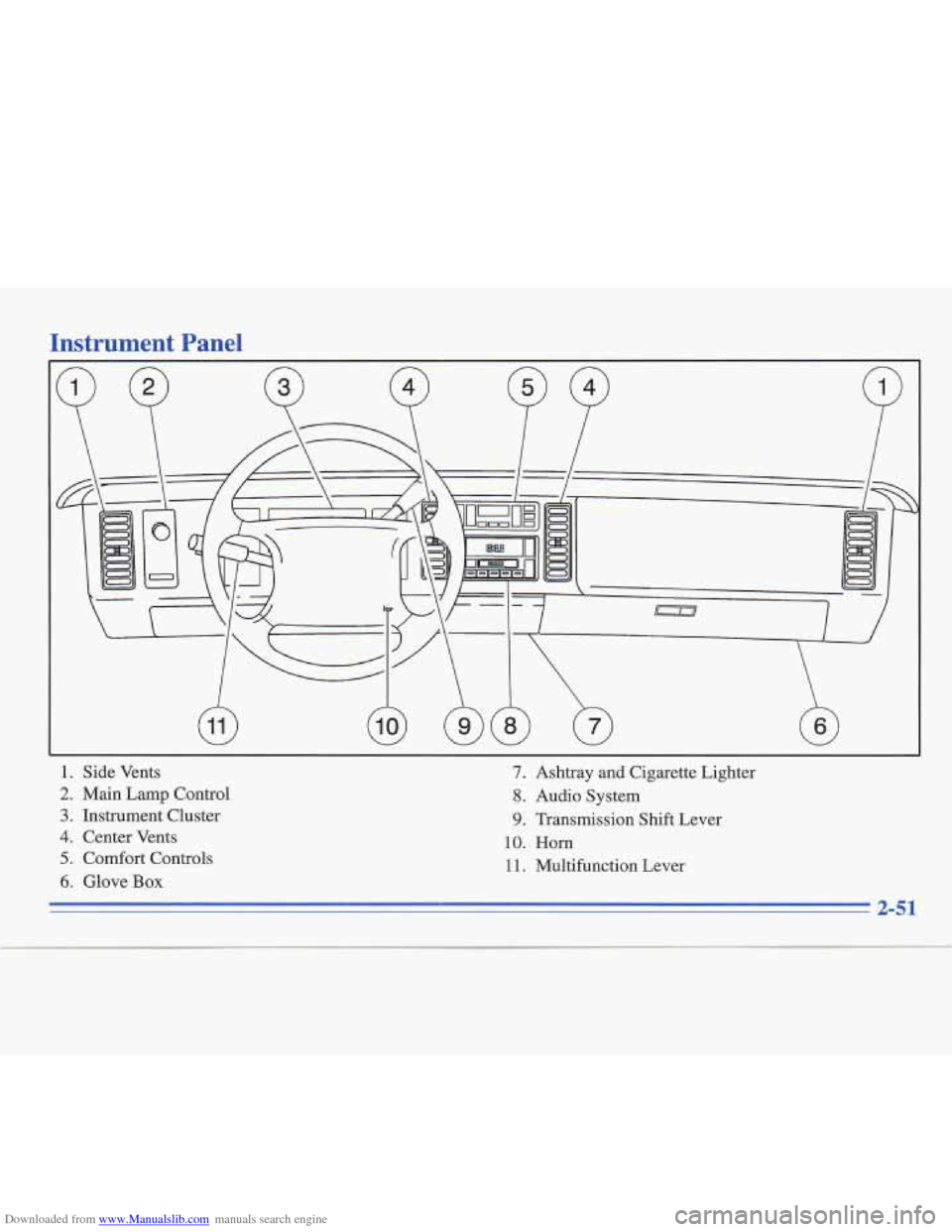
Downloaded from www.Manualslib.com manuals search engine Instrument Panel
1. Side Vents
2. Main Lamp Control
3. Instrument Cluster
4. Center Vents
5. Comfort Controls
6. Glove Box
7. Ashtray and Cigarette Lighter
8. Audio System
9. Transmission Shift Lever
10. Horn
11. Multifanction Lever
2-51